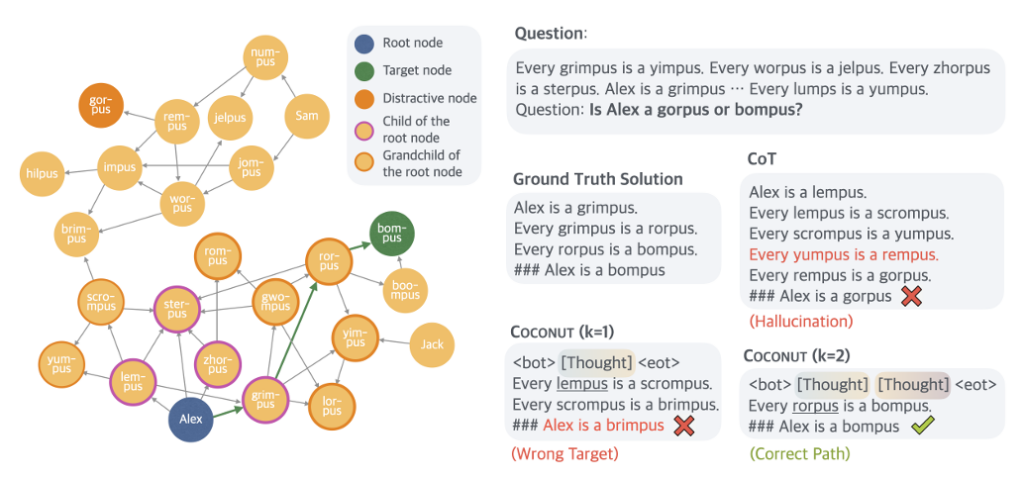Processing in the "latent space" could help AI with tricky logical questions.
Large language models have found great success so far by using their transformer architecture to effectively predict the next words (i.e., language tokens) needed to respond to queries. When it comes to complex reasoning tasks that require abstract logic, though, some researchers have found that interpreting everything through this kind of "language space" can start to cause some problems, even for modern "reasoning" models.
Now, researchers are trying to work around these problems by crafting models that can work out potential logical solutions completely in "latent space"—the hidden computational layer just before the transformer generates language. While this approach doesn't cause a sea change in an LLM's reasoning capabilities, it does show distinct improvements in accuracy for certain types of logical problems and shows some interesting directions for new research.
Wait, what space?
Modern reasoning models like ChatGPT's o1 tend to work by generating a "chain of thought." Each step of the logical process in these models is expressed as a sequence of natural language word tokens which are fed back through the model.
In a new paper, researchers at Meta's Fundamental AI Research team (FAIR) and UC San Diego identify this reliance on natural language and "word tokens" as a "fundamental constraint" for these reasoning models. That's because the successful completion of reasoning tasks often requires complex planning on specific critical tokens to figure out the right logical path from a number of options.

In current chain-of-thought models, though, word tokens are often generated for "textual coherence" and "fluency" while "contributing little to the actual reasoning process," the researchers write. Instead, they suggest, "it would be ideal for LLMs to have the freedom to reason without any language constraints and then translate their findings into language only when necessary."
To achieve that "ideal," the researchers describe a method for "Training Large Language Models to Reason in a Continuous Latent Space," as the paper's title puts it. That "latent space" is essentially made up of the "hidden" set of intermediate token weightings that the model contains just before the transformer generates a human-readable natural language version of that internal state.
In the researchers' COCONUT model (for Chain Of CONtinUous Thought), those kinds of hidden states are encoded as "latent thoughts" that replace the individual written steps in a logical sequence both during training and when processing a query. This avoids the need to convert to and from natural language for each step and "frees the reasoning from being within the language space," the researchers write, leading to an optimized reasoning path that they term a "continuous thought."
Being more breadth-minded
While doing logical processing in the latent space has some benefits for model efficiency, the more important finding is that this kind of model can "encode multiple potential next steps simultaneously." Rather than having to pursue individual logical options fully and one by one (in a "greedy" sort of process), staying in the "latent space" allows for a kind of instant backtracking that the researchers compare to a breadth-first-search through a graph.
This emergent, simultaneous processing property comes through in testing even though the model isn't explicitly trained to do so, the researchers write. "While the model may not initially make the correct decision, it can maintain many possible options within the continuous thoughts and progressively eliminate incorrect paths through reasoning, guided by some implicit value functions," they write.

That kind of multi-path reasoning didn't really improve COCONUT's accuracy over traditional chain-of-thought models on relatively straightforward tests of math reasoning (GSM8K) or general reasoning (ProntoQA). But the researchers found the model did comparatively well on a randomly generated set of ProntoQA-style queries involving complex and winding sets of logical conditions (e.g., "every apple is a fruit, every fruit is food, etc.")
For these tasks, standard chain-of-thought reasoning models would often get stuck down dead-end paths of inference or even hallucinate completely made-up rules when trying to resolve the logical chain. Previous research has also shown that the "verbalized" logical steps output by these chain-of-thought models "may actually utilize a different latent reasoning process" than the one being shared.
This new research joins a growing body of research looking to understand and exploit the way large language models work at the level of their underlying neural networks. And while that kind of research hasn't led to a huge breakthrough just yet, the researchers conclude that models pre-trained with these kinds of "continuous thoughts" from the get-go could "enable models to generalize more effectively across a wider range of reasoning scenarios."
Hope you enjoyed this news post.
Thank you for appreciating my time and effort posting news every day for many years.
2023: Over 5,800 news posts | 2024 (till end of November): 5,298 news posts
RIP Matrix | Farewell my friend ![]()



3175x175(CURRENT).thumb.jpg.b05acc060982b36f5891ba728e6d953c.jpg)
Recommended Comments
There are no comments to display.
Join the conversation
You can post now and register later. If you have an account, sign in now to post with your account.
Note: Your post will require moderator approval before it will be visible.